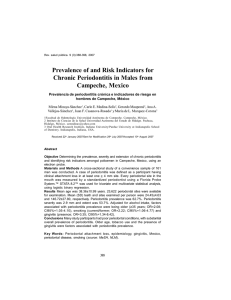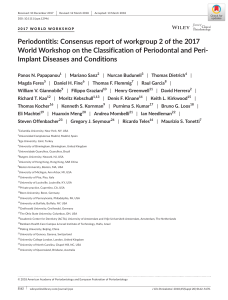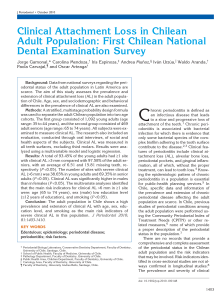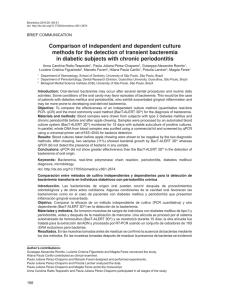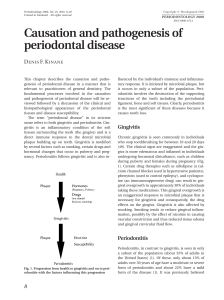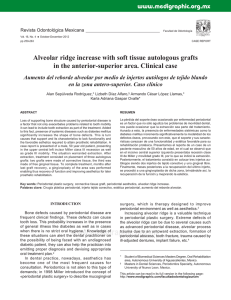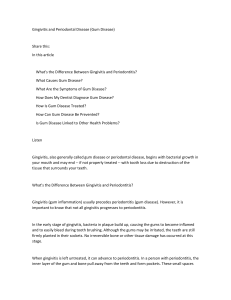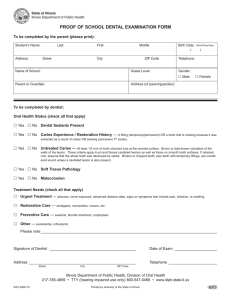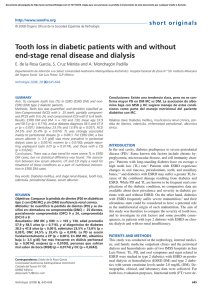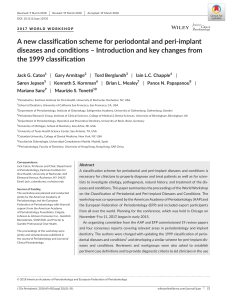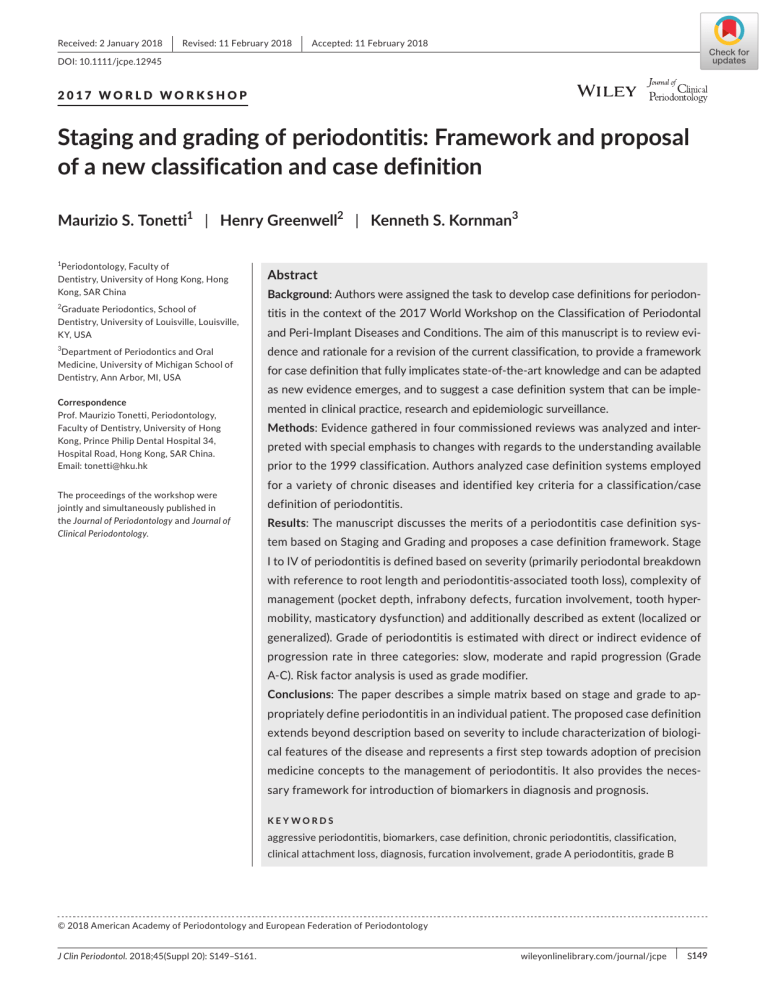
Received: 2 January 2018 | Revised: 11 February 2018 | Accepted: 11 February 2018 DOI: 10.1111/jcpe.12945 2017 WORLD WORKSHOP Staging and grading of periodontitis: Framework and proposal of a new classification and case definition Maurizio S. Tonetti1 | Henry Greenwell2 | Kenneth S. Kornman3 1 Periodontology, Faculty of Dentistry, University of Hong Kong, Hong Kong, SAR China 2 Graduate Periodontics, School of Dentistry, University of Louisville, Louisville, KY, USA Abstract Background: Authors were assigned the task to develop case definitions for periodon‐ titis in the context of the 2017 World Workshop on the Classification of Periodontal and Peri‐Implant Diseases and Conditions. The aim of this manuscript is to review evi‐ Department of Periodontics and Oral Medicine, University of Michigan School of Dentistry, Ann Arbor, MI, USA dence and rationale for a revision of the current classification, to provide a framework Correspondence Prof. Maurizio Tonetti, Periodontology, Faculty of Dentistry, University of Hong Kong, Prince Philip Dental Hospital 34, Hospital Road, Hong Kong, SAR China. Email: tonetti@hku.hk mented in clinical practice, research and epidemiologic surveillance. 3 The proceedings of the workshop were jointly and simultaneously published in the Journal of Periodontology and Journal of Clinical Periodontology. for case definition that fully implicates state‐of‐the‐art knowledge and can be adapted as new evidence emerges, and to suggest a case definition system that can be imple‐ Methods: Evidence gathered in four commissioned reviews was analyzed and inter‐ preted with special emphasis to changes with regards to the understanding available prior to the 1999 classification. Authors analyzed case definition systems employed for a variety of chronic diseases and identified key criteria for a classification/case definition of periodontitis. Results: The manuscript discusses the merits of a periodontitis case definition sys‐ tem based on Staging and Grading and proposes a case definition framework. Stage I to IV of periodontitis is defined based on severity (primarily periodontal breakdown with reference to root length and periodontitis‐associated tooth loss), complexity of management (pocket depth, infrabony defects, furcation involvement, tooth hyper‐ mobility, masticatory dysfunction) and additionally described as extent (localized or generalized). Grade of periodontitis is estimated with direct or indirect evidence of progression rate in three categories: slow, moderate and rapid progression (Grade A‐C). Risk factor analysis is used as grade modifier. Conclusions: The paper describes a simple matrix based on stage and grade to ap‐ propriately define periodontitis in an individual patient. The proposed case definition extends beyond description based on severity to include characterization of biologi‐ cal features of the disease and represents a first step towards adoption of precision medicine concepts to the management of periodontitis. It also provides the neces‐ sary framework for introduction of biomarkers in diagnosis and prognosis. KEYWORDS aggressive periodontitis, biomarkers, case definition, chronic periodontitis, classification, clinical attachment loss, diagnosis, furcation involvement, grade A periodontitis, grade B © 2018 American Academy of Periodontology and European Federation of Periodontology J Clin Periodontol. 2018;45(Suppl 20): S149–S161. wileyonlinelibrary.com/journal/jcpe | S149 S150 | TONETTI et al. periodontitis, grade C periodontitis, inflammatory burden, infrabony defect, masticatory dysfunction, necrotizing periodontitis, periodontal pocket, periodontitis, periodontitis as manifestation of systemic disease, periodontitis/grade, periodontitis/stage, radiographic bone loss, risk factors, stage I periodontitis, stage II periodontitis, stage III periodontitis, stage IV periodontitis, standard of care, tooth hypermobility, tooth loss I NTRO D U C TI O N : TH E 1999 C L A S S I FI C ATI O N O F PE R I O D O NTITI S 1. Necrotizing periodontitis 2. Chronic periodontitis 3. Aggressive periodontitis Periodontitis is characterized by microbially‐associated, host‐me‐ 4. Periodontitis as a manifestation of systemic diseases diated inflammation that results in loss of periodontal attachment. The pathophysiology of the disease has been characterized in its key The overall classification system aimed to differentiate the more molecular pathways, and ultimately leads to activation of host‐de‐ common forms of periodontitis, i.e. chronic and aggressive periodonti‐ rived proteinases that enable loss of marginal periodontal ligament tis, from the unusual necrotizing form of the disease (characterized by fibers, apical migration of the junctional epithelium, and allows api‐ a unique pathophysiology, distinct clinical presentation and treatment), cal spread of the bacterial biofilm along the root surface. The bac‐ and the rare major genetic defects or acquired deficiencies in compo‐ terial biofilm formation initiates gingival inflammation; however, nents of host defense (characterized by a primary systemic disorder periodontitis initiation and progression depend on dysbiotic ecolog‐ that also expresses itself by premature tooth exfoliation). ical changes in the microbiome in response to nutrients from gingi‐ The 1999 group consensus report on aggressive periodontitis val inflammatory and tissue breakdown products that enrich some identified specific features of this form of disease and proposed species and anti‐bacterial mechanisms that attempt to contain the the existence of major and minor criteria for case definition as well microbial challenge within the gingival sulcus area once inflamma‐ as distribution features to differentiate localized from generalized tion has initiated. Current evidence supports multifactorial disease forms of periodontitis.8 By default, cases of periodontitis that would influences, such as smoking, on multiple immunoinflammatory re‐ not satisfy the “aggressive” phenotype definition would be classified sponses that make the dysbiotic microbiome changes more likely for as “chronic” with the implication that latter cases could be managed some patients than others and likely influence severity of disease for more easily and, with appropriate therapy and maintenance care, such individuals. would rarely jeopardize the retention of a functional dentition.9 Marginal alveolar bone loss – a key secondary feature of peri‐ The rationale for differentiating between chronic and aggressive odontitis – is coupled with loss of attachment by inflammatory medi‐ periodontitis included the ability to identify and focus on the more ators. Clinical presentation differs based on age of patient and lesion problematic cases: presenting with greater severity earlier in life, number, distribution, severity, and location within the dental arch. at higher risk of progression and/or in need of specific treatment The level of oral biofilm contamination of the dentition also influ‐ approaches. ences the clinical presentation. In recent decades, attempts to classify periodontitis have cen‐ The 1999 workshop addressed a host of concerns with the clin‐ ical applicability and pathophysiologic rationale of previous classifi‐ tered on a dilemma represented by whether phenotypically different cation systems (see Armitage 199910 for discussion), emphasized the case presentations represent different diseases or just variations of need to capture differences between forms of the disease able to a single disease. Lack of ability to resolve the issue is illustrated in lead to edentulism, but did not clearly communicate differences be‐ the changes to the classification system that progressively empha‐ tween chronic and aggressive periodontitis. While the consensus re‐ sized either differences or commonalities.1,2 Shortly before the 1999 port of the aggressive periodontitis working group articulated major International Workshop on Classification of Periodontal Diseases, and minor criteria required for the aggressive periodontitis diagnosis research in the field emphasized individual features of periodontitis as well as specific definitions to identify patterns of distribution of and thus differences in phenotype. These emerged from the iden‐ lesions within the dentition (localized molar incisor versus general‐ tification of specific bacteria or bacterial complexes as etiologic ized, see Lang et al. 19998 for detailed discussion), the difficulty in agents of periodontitis,3 the recognition of the existence of multiple applying the stipulated criteria in the everyday clinical practice and modifiable risk factors, and the identification of the relevance of the substantial overlap between the diagnostic categories provided genetic susceptibility5,6 and specific polymorphisms associated with a barrier to clinicians in the application of the classification system. disease severity.7 The research perspective on the disease impacted Furthermore, the validity of many of the criteria for aggressive peri‐ the 1999 classification system that emphasized perceived unique odontitis has not been confirmed in adequately designed studies. 4 features of different periodontitis phenotypes and led to the recog‐ nition of four different forms of periodontitis: Over the past 2 decades clinicians, educators, researchers and epidemiologists have voiced concern about their ability to correctly | TONETTI et al. S151 differentiate between aggressive and chronic periodontitis cases, There is sufficient evidence to consider that periodontitis ob- and these difficulties have been a major rationale for a new classifi‐ served in the context of systemic diseases that severely impair cation workshop.11 host response should be considered a periodontal manifestation of the systemic disease and that the primary diagnosis should S U M M A RY A N D I NTE R PR E TATI O N O F E V I D E N C E FRO M CU R R E NT WO R K S H O P P OS ITI O N PA PE R S be the systemic disease according to International Statistical Classification of Disease (ICD).13,17 Many of these diseases are characterized by major functional impairment of host defenses and have multiple non‐oral sequelae. At the moment there is insuf‐ ficient evidence to consider that periodontitis observed in poorly To update evidence that has accumulated since the latest clas‐ controlled diabetes is characterized by unique pathophysiology sification workshop, the organizing committee commissioned a and/or requires specific periodontal treatment other than the con‐ review on acute periodontal lesions including necrotizing periodon‐ trol of both co‐morbidities.18 12 titis, a review of manifestations of systemic diseases that affect 13 Despite substantial research on aggressive periodontitis since and three position pa‐ the 1999 workshop,14 there is currently insufficient evidence to pers that are relevant to the discussion of aggressive and chronic consider aggressive and chronic periodontitis as two pathophysio- periodontitis.14‒16 logically distinct diseases. the periodontal attachment apparatus, The position papers that addressed aggressive and chronic peri‐ Current multifactorial models of disease applied to periodontitis odontitis reached the following overarching conclusions relative to appear to account for a substantial part of the phenotypic variation periodontitis: observed across cases as defined by clinical parameters. Multiple observational studies in populations with long‐term exposure to 1. There is no evidence of specific pathophysiology that enables microbial biofilms on the teeth have shown that a small segment differentiation of cases that would currently be classified as of the adult population expresses severe generalized periodontitis aggressive and chronic periodontitis or provides guidance for and most express mild to moderate periodontitis.19,20 It is also well different interventions. documented using twin studies that a large portion of the variance 2. There is little consistent evidence that aggressive and chronic in clinical severity of periodontitis is attributable to genetics.5,6,21,22 periodontitis are different diseases, but there is evidence of mul‐ It is reasonable to expect that future research advances will tiple factors, and interactions among them, that influence clini‐ increase our knowledge of disease‐specific mechanisms in the cally observable disease outcomes (phenotypes) at the individual context of the multifactorial biological interactions involved in spe‐ level. This seems to be true for both aggressive and chronic cific phenotypes. That pursuit may be valuable in guiding better phenotypes. management of complex cases and may lead to novel approaches 3. On a population basis, the mean rates of periodontitis progression that enhance periodontitis prevention, control, and regeneration. are consistent across all observed populations throughout the Multi‐dimensional profiles that combine biological and clinical pa‐ world. rameters are emerging that better define phenotypes and may guide 4. There is evidence, however, that specific segments of the popula‐ tion exhibit different levels of disease progression, as indicated by deeper understanding of the mechanisms that lead to differences in phenotypes.23‒26 greater severity of clinical attachment loss (CAL) in subsets of There is clinical value in individualizing the diagnosis and the case each age cohort relative to the majority of individuals in the age definition of a periodontitis patient to take into account the known cohort. 5. A classification system based only on disease severity fails to cap‐ ture important dimensions of an individual's disease, including the dimension of the multifactorial etiology to improve prognosis, ac‐ count for complexity and risk, and provide an appropriate level of care for the individual. complexity that influences approach to therapy, the risk factors that influence likely outcomes, and level of knowledge and train‐ ing required for managing the individual case. Authors’ interpretation of current evidence reviews There is sufficient evidence to consider necrotizing periodonti- I NTEG R ATI N G CU R R E NT K N OW LE D G E TO A DVA N C E C L A S S I FI C ATI O N O F PE R I O D O NTITI S Clinical definition of periodontitis tis as a separate disease entity. Evidence comes from: i) a distinct Periodontitis is characterized by microbially‐associated, host‐me‐ pathophysiology characterized by prominent bacterial invasion and diated inflammation that results in loss of periodontal attachment. ulceration of epithelium; ii) rapid and full thickness destruction of This is detected as clinical attachment loss (CAL) by circumfer‐ the marginal soft tissue resulting in characteristic soft and hard tis‐ ential assessment of the erupted dentition with a standardized sue defects; iii) prominent symptoms; and iv) rapid resolution in re‐ periodontal probe with reference to the cemento‐enamel junction sponse to specific antimicrobial treatment. (CEJ). S152 | It is important to note: TONETTI et al. parameter relative to assessment of periodontitis treatment out‐ comes and residual disease risk post‐treatment. 29‒32 However BOP 1. Some clinical conditions other than periodontitis present with clinical attachment loss. 2. Periodontitis definitions based on marginal radiographic bone itself, or as a secondary parameter with CAL, does not change the initial case definition as defined by CAL or change the classification of periodontitis severity. loss suffer from severe limitations as they are not specific enough Multiple periodontitis case definitions have been proposed in and miss detection of mild to moderate periodontitis. 27 recent years. The AAP/Centers for Disease Control (CDC) case defi‐ Periodontitis definitions based on radiographic bone loss should nition for epidemiologic surveillance and the EFP case definition for be limited to the stages of mixed dentition and tooth eruption the purpose of risk factors research have been widely utilized.33,34 when clinical attachment level measurement with reference to Although the AAP/CDC and the sensitive EFP definition share simi‐ the CEJ are impractical. 28 In such cases periodontitis assess‐ larities there are some important differences. ments based on marginal radiographic bone loss may use bitew‐ ing radiographs taken for caries detection. In the context of the 2017 World Workshop, it is suggested that a single definition be adopted. A patient is a periodontitis case in the context of clinical care if: Objectives of a periodontitis case definition system A case definition system should facilitate the identification, treat‐ 1. Interdental CAL is detectable at ≥2 non‐adjacent teeth, or 2. Buccal or oral CAL ≥3 mm with pocketing >3 mm is detectable at ≥2 teeth ment and prevention of periodontitis in individual patients. Given current knowledge, a periodontitis case definition system should and the observed CAL cannot be ascribed to non‐periodontal include three components: causes such as: 1) gingival recession of traumatic origin; 2) dental car‐ 1. Identification of a patient as a periodontitis case, on the distal aspect of a second molar and associated with malposition ies extending in the cervical area of the tooth; 3) the presence of CAL 2. Identification of the specific form of periodontitis, and or extraction of a third molar, 4) an endodontic lesion draining through 3. Description of the clinical presentation and other elements that the marginal periodontium; and 5) the occurrence of a vertical root affect clinical management, prognosis, and potentially broader in‐ fluences on both oral and systemic health. fracture. Key to periodontitis case definition is the notion of “detectable” interdental CAL: the clinician being able to specifically identify areas Furthermore, case definitions may be applied in different of attachment loss during periodontal probing or direct visual detec‐ contexts: patient care, epidemiological surveys and research on tion of the interdental CEJ during examination, taking measurement disease mechanisms or therapeutic outcomes, as discussed in error and local factors into account. Appendix A in the online Journal of Clinical Periodontology. In the It is recognized that “detectable” interdental attachment loss various contexts, case definitions may require different diagnostic may represent different magnitudes of CAL based upon the skills of characteristics based on the objectives of the specific application, the operator (e.g. specialist or general practitioner) and local condi‐ as is discussed below. tions that may facilitate or impair detection of the CEJ, most notably the position of the gingival margin with respect to the CEJ, the pres‐ Definition of a patient as a periodontitis case ence of calculus or restorative margins. The proposed case definition does not stipulate a specific threshold of detectable CAL to avoid Given the measurement error of clinical attachment level with a misclassification of initial periodontitis cases as gingivitis and main‐ standard periodontal probe, a degree of misclassification of the ini‐ tain consistency of histological and clinical definitions. There is also a tial stage of periodontitis is inevitable and this affects diagnostic ac‐ need to increase specificity of the definition and this is accomplished curacy. As disease severity increases, CAL is more firmly established, requiring detection of CAL at two non‐adjacent teeth. Setting a and a periodontitis case can be identified with greater accuracy. specific threshold of CAL for periodontitis definition (e.g. 2 mm) to Decreasing the threshold of CAL increases sensitivity. Increasing the address measurement error with CAL detection with a periodontal threshold, requiring CAL at ≥1 site, and excluding causes of CAL, probe would result in misclassification of initial periodontitis cases other than periodontitis, increases specificity. as gingivitis. Specific considerations are needed for epidemiological We should anticipate that until more robust methods are vali‐ dated, potentially salivary biomarkers or novel soft‐tissue imaging surveys where threshold definition is likely to be based on numerical values dependent on measurement errors. technologies, the level of training and experience with periodontal probing will greatly influence the identification of a case of initial periodontitis. It should be noted that periodontal inflammation, generally measured as bleeding on probing (BOP), is an important clinical Identification of the form of periodontitis Based on pathophysiology, three clearly different forms of peri‐ odontitis have been identified: | TONETTI et al. S153 1. Necrotizing periodontitis Complexity of management 2. Periodontitis as a direct manifestation of systemic diseases Factors such as probing depths,36 type of bone loss (vertical and/or 3. Periodontitis horizontal),37 furcation status,38 tooth mobility,39‒41 missing teeth, bite collapse,42 and residual ridge defect size increase treatment Differential diagnosis is based on history and the specific signs and complexity and need to be considered and should ultimately influ‐ symptoms of necrotizing periodontitis and the presence or absence ence diagnostic classification. Explicit designation of case complex‐ of an uncommon systemic disease that definitively alters the host im‐ ity factors helps to define levels of competence and experience that mune response. Necrotizing periodontitis is characterized by history a case is likely to require for optimal outcomes. of pain, presence of ulceration of the gingival margin and/or fibrin de‐ posits at sites with characteristically decapitated gingival papillae, and, Extent in some cases, exposure of the marginal alveolar bone. With regard to The number and the distribution of teeth with detectable periodon‐ periodontitis as a direct manifestation of systemic disease, the recom‐ tal breakdown has been part of current classification systems. The mendation is to follow the classification of the primary disease accord‐ number of affected teeth (as a percentage of teeth present) has been ing to the respective International Statistical Classification of Diseases used to define cases of chronic periodontitis in the 1999 classifica‐ and Related Health Problems (ICD) codes. tion9,10 while the distribution of lesions (molar incisor versus gener‐ The vast majority of clinical cases of periodontitis do not have alized pattern of breakdown) has been used as a primary descriptor the local characteristics of necrotizing periodontitis or the systemic for aggressive periodontitis.8,28 Rationale for keeping this informa‐ characteristics of a rare immune disorder with a secondary mani‐ tion in the classification system comes from the fact that specific festation of periodontitis. The majority of clinical cases of peri‐ patterns of periodontitis (e.g. the molar‐incisor pattern of younger odontitis present with a range of phenotypes that require different subjects presenting with what was formerly called localized juvenile approaches to clinical management and offer different complexities periodontitis) provide indirect information about the specific host‐ that define the knowledge and experience necessary to successfully biofilm interaction. manage various cases. Rate of progression Additional elements proposed for inclusion in the classification of periodontitis One of the most important aspects for a classification system is to properly account for variability in the rate of progression of peri‐ odontitis. The importance of this criteria has been well recognized Since the 1999 International Classification Workshop, it has be‐ in the 1989 AAP classification that identified a rapidly progressing come apparent that additional information beyond the specific form form of periodontitis.43 Concern about this criterion has been mostly of periodontitis and the severity and extent of periodontal break‐ on how to assess the rate of progression at initial examination in the down is necessary to more specifically characterize the impact of absence of direct evidence (e.g. an older diagnostic quality radio‐ past disease on an individual patient's dentition and on treatment graph allowing comparison of marginal bone loss over time). approaches needed to manage the case. Clinical diagnosis needs to be more all‐encompassing in expressing the effects of periodontitis Risk factors and should account not only for the oral effects but also for potential Recognized risk factors have not been previously included formally systemic implications of the disease. in the classification system of periodontitis but have been used as a descriptor to qualify the specific patient as a smoker or a patient Severity with diabetes mellitus. Improved knowledge of how risk factors af‐ The degree of periodontal breakdown present at diagnosis has fect periodontitis (higher severity and extent at an earlier age) and long been used as the key descriptor of the individual case of peri‐ treatment response (smaller degrees of improvements in surrogate odontitis. The 1999 case definition system is also based on sever‐ outcomes and higher rates of tooth loss during supportive periodon‐ ity. Rationale of classification according to severity encompasses tal therapy40,41,44) indicate that risk factors should be considered in at least two important dimensions: complexity of management and the classification of periodontitis. extent of disease. Important limitations of severity definitions are worth discussing also in the context of recent therapeutic improve‐ Interrelationship with general health ments that have enabled successful management of progressively Since the 1999 workshop considerable evidence has emerged con‐ more severe periodontitis. 35 Conventional definitions of severe peri‐ cerning potential effects of periodontitis on systemic diseases. odontitis need to be revised to better discriminate the more severe Various mechanisms linking periodontitis to multiple systemic dis‐ forms of periodontitis. Another important limitation of current defi‐ eases have been proposed.45,46 Specific oral bacteria in the peri‐ nitions of severe periodontitis is a paradox: whenever the worst af‐ odontal pocket may gain bloodstream access through ulcerated fected teeth in the dentition are lost, severity may actually decrease. pocket epithelium. Inflammatory mediators from the periodontium Tooth loss attributable to periodontitis needs to be incorporated in may enter the bloodstream and activate liver acute phase proteins, the definition of severity. such as C‐reactive protein (CRP), which further amplify systemic S154 | TONETTI et al. inflammation levels. Case‐control47‒50 and pilot intervention stud‐ ies 51,52 show that periodontitis contributes to the overall inflamma‐ in treatment, and may be a factor in assessing prognosis. Periodontitis staging should assist clinicians in considering all relevant dimensions tory burden of the individual which is strongly implicated in coronary that help optimize individual patient management and thus represents artery disease, stroke, and Type II diabetes. 53‒58 Initial evidence also a critical step towards personalized care (or precision medicine). supports the potential role of the overall systemic inflammatory bur‐ den on the risk for periodontitis. 59 Staging relies on the standard dimensions of severity and extent of periodontitis at presentation but introduces the dimension of Modestly sized periodontitis treatment studies of uncontrolled complexity of managing the individual patient. Type II diabetes have shown value in reducing hyperglycemia, al‐ As it is recognized that individuals presenting with different se‐ though reductions in hyperglycemia have not been supported in verity/extent and resulting complexity of management may present some larger studies where the periodontal treatment outcomes different rates of progression of the disease and/or risk factors, the in‐ were less clear.18,60,61 Although intriguing health economics anal‐ formation derived from the staging of periodontitis should be supple‐ yses have shown a reduction in cost of care for multiple medical mented by information on the inherent biological grade of the disease. conditions following treatment for periodontitis,62 little direct peri‐ This relies on three sets of parameters: 1) rate of periodontitis progres‐ odontitis intervention evidence, beyond the diabetes experience, sion; 2) recognized risk factors for periodontitis progression; and 3) risk has convincingly demonstrated the potential value of effectively of an individual's case affecting the systemic health of the subject. treating periodontitis relative to overall health benefits. Current evi- The concept and value of “staging” has been extensively devel‐ dence that effective treatment of certain cases of periodontitis can oped in the oncology field. Staging of tumors is based on current ob‐ favorably influence systemic diseases or their surrogates, although servable clinical presentation including size or extent and whether it limited, is intriguing and should definitively be assessed. has metastasized. This may be an example of how one might commu‐ Other factors that need to be considered in formulating a diag‐ nicate current severity and extent of a disease, as well as the clinical nostic classification include the medical status of the patient and the complexities of managing the case. To supplement staging, which pro‐ level of expertise needed to provide appropriate care. If the patient vides a summary of clinical presentation, grade has been used as an as‐ has severe systemic disease, as indicated by their American Society sessment of the potential for a specific tumor to progress, i.e. to grow of Anesthesiologists (ASA) status, this can seriously affect the cli‐ and spread, based on microscopic appearance of tumor cells. In addi‐ nician's ability to control disease progression due to the patient's tion, current molecular markers often guide selection of specific drug inability to withstand proper treatment or their inability to attend therapies, and thereby incorporate biological targets that increase the necessary maintenance care. granularity of the grade and thus may increase the probability of a favorable clinical outcome. These concepts have been adapted to peri‐ FR A M E WO R K FO R D E V E LO PI N G A PE R I O D O NTITI S S TAG I N G A N D G R A D I N G S YS TE M odontitis, as summarized in Table 1, and as described in detail below. While devising a general framework, it seems relevant from a patient management standpoint to differentiate four stages of peri‐ odontitis. Each of these stages is defined by unique disease presen‐ tation in terms of disease severity and complexity of management. New technologies and therapeutic approaches to periodontitis man‐ In each stage of severity, it may be useful to identify subjects with agement are now available such that clinicians with advanced train‐ ing can manage patients with moderate and severe periodontitis to achieve clinical outcomes that were not previously possible. The other dimension not previously available in our classifica‐ tion is the directed identification of individual patients who are more likely to require greater effort to prevent or control their chronic disease long‐term. This explicitly acknowledges the evidence that most individuals and patients respond predictably to conventional approaches to prevent periodontitis and conventional therapeutic approaches and maintenance, while others may require more inten‐ sive and more frequent preventive care or therapeutic interventions, monitoring, and maintenance.19,20,63‒65 Staging, an approach used for many years in oncology, has been recently discussed relative to periodontal disease 66 and affords an op‐ portunity to move beyond the one‐dimensional approach of using past destruction alone and furnishes a platform on which a multidimensional diagnostic classification can be built. Furthermore, a uniform staging system should provide a way of defining the state of periodontitis at various points in time, can be readily communicated to others to assist TA B L E 1 Primary goals in staging and grading a patient with periodontitis Staging a Periodontitis Patient • Goals ◦ Classify Severity and Extent of an individual based on currently measurable extent of destroyed and damaged tissue attributable to periodontitis ◦ Assess Complexity. Assess specific factors that may determine complexity of controlling current disease and managing long‐term function and esthetics of the patient's dentition Grading a Periodontitis Patient • Goals ◦ Estimate Future Risk of periodontitis progression and responsiveness to standard therapeutic principles, to guide intensity of therapy and monitoring ◦ Estimate Potential Health Impact of Periodontitis on systemic disease and the reverse, to guide systemic monitoring and co‐therapy with medical colleagues | TONETTI et al. TA B L E 2 S155 Framework for staging and grading of periodontitis different rates of disease progression and it is foreseen that, in the future, stage definition will be enriched by diagnostic tests enabling Stage II periodontitis definition of the biological “grade” and/or susceptibility of periodon‐ Stage II represents established periodontitis in which a carefully per‐ titis progression in the individual patient. The addition of grade may formed clinical periodontal examination identifies the characteristic be achieved by refining each individual's stage definition with a damages that periodontitis has caused to tooth support. At this stage grade A, B, or C, in which increasing grades will refer to those with of the disease process, however, management remains relatively direct or indirect evidence of different rates of periodontal break‐ simple for many cases as application of standard treatment princi‐ down and presence and level of control of risk factors. ples involving regular personal and professional bacterial removal An individual case may thus be defined by a simple matrix of stage and monitoring is expected to arrest disease progression. Careful at presentation (severity and complexity of management) and grade evaluation of the stage II patient's response to standard treatment (evidence or risk of progression and potential risk of systemic impact principles is essential, and the case grade plus treatment response of the patient's periodontitis; these also influence the complexity of may guide more intensive management for specific patients. management of the case). Table 2 illustrates this concept and pro‐ vides a general framework that will allow updates and revisions over time as specific evidence becomes available to better define individ‐ ual components, particularly in the biological grade dimension of the disease and the systemic implications of periodontitis. Stage III periodontitis At stage III, periodontitis has produced significant damage to the attachment apparatus and, in the absence of advanced treatment, tooth loss may occur. The stage is characterized by the presence of Stage I periodontitis deep periodontal lesions that extend to the middle portion of the root and whose management is complicated by the presence of deep Stage I periodontitis is the borderland between gingivitis and peri‐ intrabony defects, furcation involvement, history of periodontal odontitis and represents the early stages of attachment loss. As tooth loss/exfoliation, and presence of localized ridge defects that such, patients with stage I periodontitis have developed periodon‐ complicate implant tooth replacement. In spite of the possibility of titis in response to persistence of gingival inflammation and bio‐ tooth loss, masticatory function is preserved, and treatment of peri‐ film dysbiosis. They represent more than just an early diagnosis: odontitis does not require complex rehabilitation of function. if they show a degree of clinical attachment loss at a relatively early age, these patients may have heightened susceptibility to disease onset. Early diagnosis and definition of a population of susceptible individuals offers opportunities for early intervention Stage IV periodontitis At the more advanced stage IV, periodontitis causes considerable and monitoring that may prove more cost‐effective at the popula‐ damage to the periodontal support and may cause significant tooth tion level as shallow lesions may provide specific options for both loss, and this translates to loss of masticatory function. In the ab‐ conventional mechanical biofilm removal and pharmacological sence of proper control of the periodontitis and adequate rehabilita‐ agents delivered in oral hygiene aids. It is recognized that early tion, the dentition is at risk of being lost. diagnosis may be a formidable challenge in general dental prac‐ This stage is characterized by the presence of deep periodontal tice: periodontal probing to estimate early clinical attachment loss lesions that extend to the apical portion of the root and/or history of – the current gold standard for defining periodontitis – may be multiple tooth loss; it is frequently complicated by tooth hypermobil‐ inaccurate. Assessment of salivary biomarkers and/or new imaging ity due to secondary occlusal trauma and the sequelae of tooth loss: technologies may increase early detection of stage I periodontitis posterior bite collapse and drifting. Frequently, case management in a variety of settings. requires stabilization/restoration of masticatory function. S156 | TONETTI et al. the teeth with the most severe periodontitis. Such challenges again Grade of periodontitis require a framework that will adapt to change as more precise ways Irrespective of the stage at diagnosis, periodontitis may progress to estimate individual susceptibility become available. with different rates in individuals, may respond less predictably to treatment in some patients, and may or may not influence general health or systemic disease. This information is critical for precision Integrating biomarkers in a case definition system medicine but has been an elusive objective to achieve in clinical Clinical parameters are very effective tools for monitoring the practice. In recent years, validated risk assessment tools25,67 and health‐disease states in most patients, likely because they respond presence of individually validated risk factors65 have been associ‐ favorably to the key principles of periodontal care, which include ated with tooth loss, indicating that it is possible to estimate risk of regular disruption, and reduction of the gingival and subgingival mi‐ periodontitis progression and tooth loss. crobiota. Current evidence suggests, however, that some individuals In the past, grade of periodontitis progression has been incorpo‐ are more susceptible to develop periodontitis, more susceptible to rated into the classification system by defining specific forms of peri‐ develop progressive severe generalized periodontitis, less respon‐ odontitis with high(er) rates of progression or presenting with more sive to standard bacterial control principles for preventing and treat‐ severe destruction relatively early in life.28 One major limitation in ing periodontitis, and theoretically more likely to have periodontitis the implementation of this knowledge has been the assumption that adversely impact systemic diseases. such forms of periodontitis represent different entities and thus focus If, due to multiple factors, such individuals are more likely than has been placed on identification of the form rather than the factors others to develop and maintain a dysbiotic microbiota in concert contributing to progression. The reviews commissioned for this work‐ with chronic periodontal inflammation; it is unclear whether current shop13–16 have indicated that there is no evidence to suggest that clinical parameters are sufficient to monitor disease development such forms of periodontitis have a unique pathophysiology, rather the and treatment responses in such patients. For those individuals, bio‐ complex interplay of risk factors in a multifactorial disease model may markers, some of which are currently available, may be valuable to explain the phenotypes of periodontitis in exposed patients. In this augment information provided by standard clinical parameters. context, it seems useful to provide a framework for implementation of Biomarkers may contribute to improved diagnostic accuracy in biological grade (risk or actual evidence of progression) of periodontitis. the early detection of periodontitis and are likely to provide decisive Recognized risk factors, such as cigarette smoking or metabolic contributions to a better assessment of the grade of periodontitis. control of diabetes, affect the rate of progression of periodontitis They may assist both in staging and grading of periodontitis. The and, consequently, may increase the conversion from one stage to proposed framework allows introduction of validated biomarkers in the next. Emerging risk factors like obesity, specific genetic factors, the case definition system. physical activity, or nutrition may one day contribute to assessment, and a flexible approach needs to be devised to ensure that the case‐ definition system will adapt to the emerging evidence. Disease severity at presentation/diagnosis as a function of pa‐ tient age has also been an important indirect assessment of the level of individual susceptibility. While not ideal – as it requires significant Integrating knowledge of the interrelationship between periodontal health and general health in a case definition system At present there is only emerging evidence to identify specific peri‐ disease at an early age or minimal disease at advanced age – this odontitis cases in which periodontal treatment produces general concept has been used in clinical practice and risk assessment tools health benefits. it is important to identify approaches to capture to identify highly susceptible or relatively resistant individuals. One some dimensions of the potential systemic impact of a specific peri‐ approach has been the assessment of bone loss in relation to pa‐ odontitis case and its treatment to provide the basis for focusing at‐ tient age by measuring radiographic bone loss in percentage of root tention on this issue and beginning to collect evidence necessary to length divided by the age of the patient. This approach was originally assess whether effective treatment of certain cases of periodontitis applied in a longitudinal assessment of disease progression assessed truly influence systemic disease in a meaningful way. in intraoral radiographs68,69 and was later incorporated in the theo‐ Specific considerations for use of the staging and grading of retical concept that led to development of the periodontal risk as‐ periodontitis with epidemiological and research applications are dis‐ sessment (PRA) system.31,70 More recently, an individual's severity cussed in Appendix B in the online Journal of Clinical Periodontology. 16 of CAL has been compared to his/her age cohort. This information from large and diverse populations could be considered an age stan‐ dard for CAL, with the assumption that individuals who exceed the mean CAL threshold for a high percentile in the age cohort would be one additional piece of objective information that may represent I N CO R P O R ATI O N O F S TAG I N G A N D G R A D I N G I N TH E C A S E D E FI N ITI O N S YS TE M O F PE R I O D O NTITI S increased risk for future progression. The CAL must be adjusted in some way based on number of missing teeth to avoid biasing the A case definition system needs to be a dynamic process that will CAL based on measuring only remaining teeth after extraction of require revisions over time in much the same way the tumor, node, | TONETTI et al. TA B L E 3 S157 Periodontitis stage – Please see text and appendix A (in online Journal of Clinical Periodontology) for explanation The initial stage should be determined using CAL; if not available then RBL should be used. Information on tooth loss that can be attributed primarily to periodontitis – if available – may modify stage definition. This is the case even in the absence of complexity factors. Complexity factors may shift the stage to a higher level, for example furcation II or III would shift to either stage III or IV irrespective of CAL. The distinction between stage III and stage IV is primarily based on complexity factors. For example, a high level of tooth mobility and/or posterior bite collapse would indicate a stage IV diagnosis. For any given case only some, not all, complexity factors may be present, however, in general it only takes one complexity factor to shift the diagnosis to a higher stage. It should be emphasized that these case definitions are guidelines that should be applied using sound clinical judgment to arrive at the most appropriate clinical diagnosis. For post‐treatment patients CAL and RBL are still the primary stage determinants. If a stage‐shifting complexity factor(s) is eliminated by treatment, the stage should not retrogress to a lower stage since the original stage complexity factor should always be considered in maintenance phase management. CAL = clinical attachment loss; RBL = radiographic bone loss. metastasis (TNM) staging system for cancer has been shaped over many decades. It needs to be: Stage of periodontitis (Table 3) At present, relevant data are available to assess the two dimensions 1. Simple enough to be clinically applicable but not simplistic: of the staging process: severity and complexity. These can be as‐ additional knowledge has distinguished dimensions of periodon‐ sessed in each individual case at diagnosis by appropriate anamnes‐ titis, such as complexity of managing the case to provide the tic, clinical, and imaging data. best level of care 2. Standardized to be able to support effective communication among all stakeholders 3. Accessible to a wide range of people in training and understood The severity score is primarily based on interdental CAL in rec‐ ognition of low specificity of both pocketing and marginal bone loss, although marginal bone loss is also included as an additional descrip‐ tor. It follows the general frame of previous severity‐based scores by members of the oral health care team around the world and is assigned based on the worst affected tooth in the dentition. It is suggested that a case definition based on a matrix of periodon‐ score. Only attachment loss attributable to periodontitis is used for the titis stage and periodontitis grade be adopted. Such multidimensional The complexity score is based on the local treatment com‐ view of periodontitis would create the potential to transform our view plexity assuming the wish/need to eliminate local factors and of periodontitis. And the powerful outcome of that multidimensional takes into account factors like presence of vertical defects, fur‐ view is the ability to communicate better with patients, other profes‐ cation involvement, tooth hypermobility, drifting and/or flar‐ sionals, and third parties. ing of teeth, tooth loss, ridge deficiency and loss of masticatory S158 | function. Besides the local complexity, it is recognized that indi‐ TONETTI et al. establishment of prognosis for the individual patient. If the patient vidual case management may be complicated by medical factors has risk factors that have been associated with more disease pro‐ or comorbidities. gression or less responsiveness to bacterial reduction therapies, the The diagnostic classification presented in Table 3 provides defi‐ risk factor information can be used to modify the estimate of the pa‐ nitions for four stages of periodontitis. In using the table, it is im‐ tient's future course of disease. A risk factor, should therefore shift portant to use CAL as the initial stage determinant in the severity the grade score to a higher value independently of the primary cri‐ dimension. It is recognized that in clinical practice application some terion represented by the rate of progression. For example, a stage clinicians may prefer to use diagnostic quality radiographic imaging and grade case definition could be characterized by moderate at‐ as an indirect and somehow less sensitive assessment of periodontal tachment loss (stage II), the assumption of moderate rate of progres‐ breakdown. This may be all that is necessary to establish the stage. sion (grade B) modified by the presence of poorly controlled Type II However, if other factors are present in the complexity dimension diabetes (a risk factor that is able to shift the grade definition to rapid that influence the disease then modification of the initial stage as‐ progression or grade C). signment may be required. For example, in case of very short com‐ mon root trunk a CAL of 4 mm may have resulted in class II furcation In summary, a periodontitis diagnosis for an individual patient should encompass three dimensions: involvement, hence shifting the diagnosis from stage II to stage III periodontitis. Likewise, if posterior bite collapse is present then the stage IV would be the appropriate stage diagnosis since the com‐ plexity is on the stage IV level. Evidence for defining different stages based on CAL/bone loss in relation to root length is somewhat arbitrary. 1. Definition of a periodontitis case based on detectable CAL loss at two non‐adjacent teeth 2. Identification of the form of periodontitis: necrotizing periodonti‐ tis, periodontitis as a manifestation of systemic disease or periodontitis Patients who have been treated for periodontitis may be pe‐ 3. Description of the presentation and aggressiveness of the disease riodically staged to monitor them. In most of successfully treated by stage and grade (see Appendix B in online Journal of Clinical patients, complexity factors that might have contributed to base‐ Periodontology) line staging will have been resolved through treatment. In such patients CAL and radiographic bone loss (RBL) will be the pri‐ mary stage determinants. If a stage shifting complexity factor(s) CO N C LU S I O N S were eliminated by treatment, the stage should not retrogress to a lower stage since the original stage complexity factor should The proposed staging and grading of periodontitis provides an always be considered in maintenance phase management. A no‐ individual patient assessment that classifies patients by two di‐ table exception is successful periodontal regeneration that may, mensions beyond severity and extent of disease that identify pa‐ through improvement of tooth support, effectively improve CAL tients as to complexity of managing the case and risk of the case and RBL of the specific tooth. exhibiting more progression and/or responding less predictably to standard periodontal therapy. The proposed risk stratification Grade of periodontitis (Table 4) is based on well‐validated risk factors including smoking, uncon‐ trolled Type II diabetes, clinical evidence of progression or disease Grading adds another dimension and allows rate of progression to diagnosis at an early age, and severity of bone loss relative to pa‐ be considered. Table 4 illustrates periodontitis grading based on tient age. primary criteria represented by the availability of direct or indirect The proposed staging and grading explicitly acknowledges the evidence of periodontitis progression. Direct evidence is based on potential for some cases of periodontitis to influence systemic longitudinal observation available for example in the form of older disease. The current proposal does not intend to minimize the im‐ diagnostic quality radiographs. Indirect evidence is based on the portance or extent of evidence supporting direct distal effects of assessment of bone loss at the worst affected tooth in the den‐ periodontal bacteremia on adverse pregnancy outcomes and po‐ tition as a function of age (measured as radiographic bone loss tentially other systemic conditions; but focuses on the role of peri‐ in percentage of root length divided by the age of the subject). odontitis as the second most frequent factor (obesity being the most Periodontitis grade can then be modified by the presence of risk frequent) that is well‐documented as a modifiable contributor to factors. systemic inflammatory burden. The objective of grading is to use whatever information is avail‐ The proposed staging and grading is designed to avoid the able to determine the likelihood of the case progressing at a greater paradox of improvement of disease severity observed after loss/ rate than is typical for the majority of the population or responding extraction of the more compromised teeth. This is achieved by incor‐ less predictably to standard therapy. porating, whenever available, knowledge about periodontitis being Clinicians should approach grading by assuming a moderate the predominant reason for loss of one or more teeth. rate of progression (grade B) and look for direct and indirect mea‐ Finally, one of the strong benefits of the staging and grading of sures of actual progression in the past as a means of improving the periodontitis is that it is designed to accommodate regular review | TONETTI et al. TA B L E 4 S159 Periodontitis grade – Please see text and appendix A (in online Journal of Clinical Periodontology) for explanation Grade should be used as an indicator of the rate of periodontitis progression. The primary criteria are either direct or indirect evidence of progression. Whenever available, direct evidence is used; in its absence indirect estimation is made using bone loss as a function of age at the most affected tooth or case presentation (radiographic bone loss expressed as percentage of root length divided by the age of the subject, RBL/age). Clinicians should ini‐ tially assume grade B disease and seek specific evidence to shift towards grade A or C, if available. Once grade is established based on evidence of progression, it can be modified based on the presence of risk factors. a Refers to increased risk that periodontitis may be an inflammatory comorbidity for the specific patient. CRP values represent a summation of the pa‐ tient's overall systemic inflammation, which may be in part influenced by periodontitis, but otherwise is an “unexplained” inflammatory burden that be valuable to assess in collaboration with the patient's physicians. The grey color of the table cells refers to the need to substantiate with specific evi‐ dence. This element is placed in the table to draw attention to this dimension of the biology of periodontitis. It is envisaged that in the future it will be possible to integrate the information into periodontitis grade to highlight the potential of systemic impact of the disease in the specific case. Question marks in the last row indicate that specific biomarkers and their thresholds may be incorporated in the table as evidence will become avaialble. HbA1c, glycated hemoglobin; hsCRP, high sensitivity C‐reactive protein; PA, periapical; CAL, clinical attachment loss. by an ad hoc international task force to ensure that the framework Genetics, which has patents covering genetic patterns in periodontal incorporates relevant new knowledge within an already functioning disease. Dr. Greenwell reports no conflicts of interest. clinical application. AC K N OW L E D G M E N T S A N D D I S C LO S U R E S Dr. Tonetti gratefully acknowledges support from the European Research Group on Periodontology (ERGOPerio, Genova, Italy) and grant support and/or personal fees from Straumann AG, Geistlich AG, Sunstar SA, Procter & Gamble, Unilever, and the Osteology Foundation. Dr. Kornman was previously employed by Interleukin REFERENCES 1. Proceedings of the World Workshop in Clinical Periodontics. Princeton, New Jersey, July 23–27, 1989. In: Nevins M, Becker W, Kornman K, eds. Chicago: American Academy of Periodontology; 1989. 2. Proceedings of the 1st European Workshop on Periodontics, 1993. London: Quintessence; 1994. 3. Socransky SS, Haffajee AD, Cugini MA, Smith C. Microbial com‐ plexes in subgingival plaque. J Clin Periodontol. 1998;25:134–144. S160 | 4. Papapanou PN. Periodontal diseases: epidemiology. Ann Periodontol. 1996;1:1–36. 5. Michalowicz BS, Aeppli DP, Kuba RK, et al. A twin study of genetic variation in proportional radiographic alveolar bone height. J Dent Res. 1991;70:1431–1435. 6. Michalowicz BS, Diehl SR, Gunsolley JC, et al. Evidence of a sub‐ stantial genetic basis for risk of adult periodontitis. J Periodontol. 2000;71:1699–1707. 7. Kornman KS, Crane A, Wang HY, et al. The interleukin‐1 genotype as a severity factor in adult periodontal disease. J Clin Periodontol. 1997;24:72–77. 8. Lang NP, Bartold PM, Cullinan M, et al. Consensus report: aggres‐ sive periodontitis. Ann Periodontol. 1999;4:53. 9. Lindhe J, Ranney R, Lamster I, et al. Consensus report: chronic peri‐ odontitis. Ann Periodontol. 1999;4:38. 10. Armitage GC. Development of a classification system for periodon‐ tal diseases and conditions. Ann Periodontol. 1999;4:1–6. 11. American Academy of Periodontology task force report on the up‐ date to the 1999 classification of periodontal diseases and condi‐ tions. J Periodontol. 2015;86:835–838. 12. Herrera D, Retamal‐Valdes B, Alonso B, Feres M. Acute periodontal lesions (periodontal abscesses and necrotizing periodontal diseases) and endo‐periodontal lesions. J Clin Periodontol. 2018;45(Suppl 20):S78–S94. 13. Albandar JM, Susin C, Hughes FJ. Manifestations of systemic diseases and conditions that affect the periodontal attachment apparatus: case definitions and diagnostic considerations. J Clin Periodontol. 2018;45(Suppl 20):S171–S189. 14. Fine DH, Patil AG, Loos BG. Classification and diagnosis of ag‐ gressive periodontitis. J Clin Periodontol. 2018;45(Suppl 20): S95–S111. 15. Needleman I, Garcia R, Gkranias N, et al. Mean annual attachment, bone level and tooth loss: a systematic review. J Clin Periodontol. 2018;45(Suppl 20):S112–S129. 16. Billings M, Holtfreter B, Papapanou PN, Mitnik GL, Kocher T, Dye BA. Age‐dependent distribution of periodontitis in two countries: findings from NHANES 2009‐2014 and SHIP‐TREND 2008‐2012. J Clin Periodontol. 2018;45(Suppl 20):S130–S148. 17. Holmstrup P, Plemons J, Meyle J. Non–plaque‐induced gingival dis‐ eases. J Clin Periodontol. 2018;45(Suppl 20):S28–S43. 18. Sanz M, Ceriello A, Buysschaert M, et al. Scientific evidence on the links between periodontal diseases and diabetes: consensus report and guidelines of the joint workshop on periodontal dis‐ eases and diabetes by the International Diabetes Federation and the European Federation of Periodontology. J Clin Periodontol. 2018;45:138–149. 19. Loe H, Anerud A, Boysen H, Morrison E. Natural history of peri‐ odontal disease in man. Rapid, moderate and no loss of attach‐ ment in Sri Lankan laborers 14 to 46 years of age. J Clin Periodontol. 1986;13:431–445. 20. Baelum V, Fejerskov O, Karring T. Oral hygiene, gingivitis and periodontal breakdown in adult Tanzanians. J Periodontal Res. 1986;21:221–232. 21. Michalowicz BS. Genetic and heritable risk factors in periodontal disease. J Periodontol. 1994;65:479–488. 22. Michalowicz BS, Aeppli D, Virag JG, et al. Periodontal findings in adult twins. J Periodontol. 1991;62:293–299. 23. Beck JD, Moss KL, Morelli T, Offenbacher S. Periodontal profile class (PPC) is associated with prevalent diabetes, coronary heart disease, stroke, and systemic markers of C‐reactive protein and in‐ terleukin‐6. J Periodontol. 2018;89:157–165. 24. Beck JD, Moss KL, Morelli T, Offenbacher S. In search of appropri‐ ate measures of periodontal status: the periodontal profile pheno‐ type (P3) system. J Periodontol. 2018;89:166–175. TONETTI et al. 25. Morelli T, Moss KL, Preisser JS, et al. Periodontal profile classes pre‐ dict periodontal disease progression and tooth loss. J Periodontol. 2018;89:148–156. 26. Kebschull M, Demmer RT, Grun B, Guarnieri P, Pavlidis P, Papapanou PN. Gingival tissue transcriptomes identify distinct periodontitis phenotypes. J Dent Res. 2014;93:459–468. 27. Lang NP, Hill RW. Radiographs in periodontics. J Clin Periodontol. 1977;4:16–28. 28. Tonetti MS, Mombelli A. Early‐onset periodontitis. Ann Periodontol. 1999;4:39–53. 29. Lang NP, Adler R, Joss A, Nyman S. Absence of bleeding on probing. An indicator of periodontal stability. J Clin Periodontol. 1990;17:714–721. 30. Lang NP, Joss A, Orsanic T, Gusberti FA, Siegrist BE. Bleeding on probing. A predictor for the progression of periodontal disease. J Clin Periodontol. 1986;13:590–596. 31. Lang NP, Tonetti MS. Periodontal risk assessment (PRA) for patients in supportive periodontal therapy (SPT). Oral Health Prev Dent. 2003;1:7–16. 32. Ramseier CA, Mirra D, Schutz C, et al. Bleeding on probing as it re‐ lates to smoking status in patients enrolled in supportive periodon‐ tal therapy for at least 5 years. J Clin Periodontol. 2015;42:150–159. 33. Eke PI, Page RC, Wei L, Thornton‐Evans G, Genco RJ. Update of the case definitions for population‐based surveillance of periodontitis. J Periodontol. 2012;83:1449–1454. 34. Tonetti MS. Claffey N, European Workshop in Periodontology group C. Advances in the progression of periodontitis and pro‐ posal of definitions of a periodontitis case and disease progres‐ sion for use in risk factor research. Group C consensus report of the 5th European Workshop in Periodontology. J Clin Periodontol. 2005;32(Suppl 6):210–213. 35. Cortellini P, Stalpers G, Mollo A, Tonetti MS. Periodontal regen‐ eration versus extraction and prosthetic replacement of teeth severely compromised by attachment loss to the apex: 5‐year results of an ongoing randomized clinical trial. J Clin Periodontol. 2011;38:915–924. 36. Lindhe J, Westfelt E, Nyman S, Socransky SS, Haffajee AD. Long‐ term effect of surgical/non‐surgical treatment of periodontal dis‐ ease. J Clin Periodontol. 1984;11:448–458. 37. Papapanou PN, Wennstrom JL. The angular bony defect as indicator of further alveolar bone loss. J Clin Periodontol. 1991;18:317–322. 38. Nibali L, Zavattini A, Nagata K, et al. Tooth loss in molars with and without furcation involvement ‐ a systematic review and meta‐ analysis. J Clin Periodontol. 2016;43:156–166. 39. Nyman SR, Lang NP. Tooth mobility and the biological rationale for splinting teeth. Periodontol 2000. 1994;4:15–22. 40. McGuire MK, Nunn ME. Prognosis versus actual outcome. III. The effectiveness of clinical parameters in accurately predicting tooth survival. J Periodontol. 1996;67:666–674. 41. Chambrone L, Chambrone D, Lima LA, Chambrone LA. Predictors of tooth loss during long‐term periodontal maintenance: a sys‐ tematic review of observational studies. J Clin Periodontol. 2010;37:675–684. 42. Nyman S, Lindhe J. Prosthetic rehabilitation of patients with ad‐ vanced periodontal disease. J Clin Periodontol. 1976;3:135–147. 43. Proceedings of the World Workshop in Clinical Periodontics. Princeton, New Jersey, July 23–27, 1989. In: Nevins M, Becker W, Kornman K, eds. Chicago: American Academy of Periodontology; 1989. 44. McGuire MK, Nunn ME. Prognosis versus actual outcome. IV. The effectiveness of clinical parameters and IL‐1 genotype in ac‐ curately predicting prognoses and tooth survival. J Periodontol. 1999;70:49–56. 45. Sanz M, Kornman K, working group 3 of the joint EFP/AAP workshop. Periodontitis and adverse pregnancy outcomes: | TONETTI et al. 46. 47. 48. 49. 50. 51. 52. 53. 54. 55. 56. 57. 58. 59. 60. consensus report of the Joint EFP/AAP Workshop on Periodontitis and Systemic Diseases. J Periodontol. 2013;84(4 Suppl.):S164–169. Tonetti MS, Van Dyke TE, working group 1 of the joint EFP/AAP workshop. Periodontitis and atherosclerotic cardiovascular disease: consensus report of the Joint EFP/AAP Workshop on Periodontitis and Systemic Diseases. J Periodontol. 2013;84(4 Suppl.):S24–29. Paraskevas S, Huizinga JD, Loos BG. A systematic review and meta‐ analyses on C‐reactive protein in relation to periodontitis. J Clin Periodontol. 2008;35:277–290. Loos BG, Craandijk J, Hoek FJ, Wertheim‐van Dillen PM, van der Velden U. Elevation of systemic markers related to cardiovas‐ cular diseases in the peripheral blood of periodontitis patients. J Periodontol. 2000;71:1528–1534. Ebersole JL, Machen RL, Steffen MJ, Willmann DE. Systemic acute‐ phase reactants, C‐reactive protein and haptoglobin, in adult peri‐ odontitis. Clin Exp Immunol. 1997;107:347–352. Teeuw WJ, Slot DE, Susanto H, et al. Treatment of periodontitis improves the atherosclerotic profile: a systematic review and meta‐ analysis. J Clin Periodontol. 2014;41:70–79. D'Aiuto F, Nibali L, Parkar M, Suvan J, Tonetti MS. Short‐term ef‐ fects of intensive periodontal therapy on serum inflammatory markers and cholesterol. J Dent Res. 2005;84:269–273. D'Aiuto F, Orlandi M, Gunsolley JC. Evidence that periodontal treatment improves biomarkers and CVD outcomes. J Periodontol. 2013;84:S85‐S105. Dregan A, Charlton J, Chowienczyk P, Gulliford MC. Chronic in‐ flammatory disorders and risk of type 2 diabetes mellitus, coro‐ nary heart disease, and stroke: a population‐based cohort study. Circulation. 2014;130:837–844. Ridker PM. High‐sensitivity C‐reactive protein: potential adjunct for global risk assessment in the primary prevention of cardiovas‐ cular disease. Circulation. 2001;103:1813–1818. Ridker PM. High‐sensitivity C‐reactive protein, inflammation, and cardiovascular risk: from concept to clinical practice to clinical ben‐ efit. Am Heart J. 2004;148:S19–26. Ridker PM, Buring JE, Cook NR, Rifai N. C‐reactive protein, the metabolic syndrome, and risk of incident cardiovascular events: an 8‐year follow‐up of 14 719 initially healthy American women. Circulation. 2003;107:391–397. Ridker PM, Cannon CP, Morrow D, et al. C‐reactive protein levels and outcomes after statin therapy. N Engl J Med. 2005;352:20–28. European Federation of Periodontology and American Academy of Periodontology. Periodontitis and systemic diseases ‐ Proceedings of a workshop jointly held by the European Federation of Periodontology and American Academy of Periodontology. Tonetti M, Kornman KS, eds. 2013. Pink C, Kocher T, Meisel P, et al. Longitudinal effects of sys‐ temic inflammation markers on periodontitis. J Clin Periodontol. 2015;42:988–997. Engebretson SP, Hyman LG, Michalowicz BS, et al. The effect of nonsurgical periodontal therapy on hemoglobin A1c levels in 61. 62. 63. 64. 65. 66. 67. 68. 69. 70. 71. S161 persons with type 2 diabetes and chronic periodontitis: a random‐ ized clinical trial. JAMA. 2013;310:2523–2532. Madianos PN, Koromantzos PA. An update of the evidence on the potential impact of periodontal therapy on diabetes outcomes. J Clin Periodontol. 2018;45:188–195. Jeffcoat MK, Jeffcoat RL, Gladowski PA, Bramson JB, Blum JJ. Impact of periodontal therapy on general health: evidence from insurance data for five systemic conditions. Am J Prev Med. 2014;47:166–174. Lindhe J, Nyman S. Long‐term maintenance of patients treated for advanced periodontal disease. J Clin Periodontol. 1984;11:504–514. Hirschfeld L, Wasserman B. A long‐term survey of tooth loss in 600 treated periodontal patients. J Periodontol. 1978;49:225–237. Giannobile WV, Braun TM, Caplis AK, Doucette‐Stamm L, Duff GW, Kornman KS. Patient stratification for preventive care in den‐ tistry. J Dent Res. 2013;92:694–701. Tonetti MS, Jepsen S, Jin L, Otomo‐Corgel J. Impact of the global burden of periodontal diseases on health, nutrition and wellbeing of mankind: a call for global action. J Clin Periodontol. 2017;44:456–462. Lang NP, Suvan JE, Tonetti MS. Risk factor assessment tools for the prevention of periodontitis progression a systematic review. J Clin Periodontol. 2015;42(Suppl 16):S59–70. Papapanou PN, Wennstrom JL, Grondahl K. A 10‐year retrospec‐ tive study of periodontal disease progression. J Clin Periodontol. 1989;16:403–411. Papapanou PN. Patterns of alveolar bone loss in the assessment of periodontal treatment priorities. Swed Dent J Suppl. 1989;66:1–45. Tonetti MS. Cigarette smoking and periodontal diseases: etiology and management of disease. Ann Periodontol. 1998;3:88–101. Holtfreter B, Albandar JM, Dietrich T, et al. Standards for report‐ ing chronic periodontitis prevalence and severity in epidemiologic studies: proposed standards from the Joint EU/USA Periodontal Epidemiology Working Group. J Clin Periodontol. 2015;42:407–412. S U P P O R T I N G I N FO R M AT I O N Additional supporting information may be found online in the Supporting Information section at the end of the article. How to cite this article: Tonetti MS, Greenwell H, Kornman KS. Staging and grading of periodontitis: Framework and proposal of a new classification and case definition. J Clin Periodontol. 2018;45(Suppl 20):S149–S161. https://doi. org/10.1111/jcpe.12945
